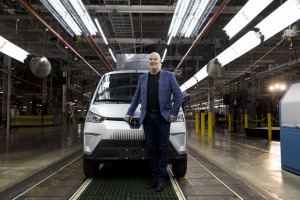Subscriber Benefit
As a subscriber you can listen to articles at work, in the car, or while you work out. Subscribe NowSPACs intrigued Taylor. Since leaving GM in 2010, he had done stints at a pair of electric vehicle companies – what are now Workhorse Group and Karma Automotive—and seen enough of the traditional fundraising process to know that he’d be happy to fast-forward through it. “This allows you to get the money much quicker,” he says, “and it arrives in a gigantic trainload.”
In fall 2020, Taylor and Luo began discussing a merger with a SPAC called Forum Merger III, which recently had raised $250 million. By late October, they were ready to approach private equity firms, hedge funds and investment banks about adding to this pool of funds through a so-called private investment in public equities, or PIPE. In December, Forum announced the planned merger, which valued ELMS at $1.4 billion. With $155 million in PIPE money, the deal was set to generate nearly $380 million in gross proceeds for ELMS.
The companies originally hoped to close the deal in the first three months of 2021, but that was delayed after the Securities and Exchange Commission began to scrutinize SPACs more closely. The EV companies that preceded ELMs into the public markets had illustrated the downside to giving startups a big bucket of money all at once: Few live up to their hype. After refiling paperwork to meet new SEC guidance, ELMS completed the merger and began trading on the Nasdaq at the end of June. As soon as the funds were in the bank, Taylor made a $30 million down payment on the $145 million purchase of the Mishawaka plant and beginning outfitting it to assemble electric vans.
ELMS is taking a crawl-before-you-walk approach to production. For now, the vans arrive in Indiana from factories in China as “pushers,” complete with chassis, frames, battery packs and wheels. At Mishawaka, a couple of dozen hourly workers spread across a handful of stations add steering wheels and a few electronic components. It’s a comedown from the Hummer days, but if all goes according to plan ELMs could bring the plant back to something approximating that scale.
Over time, the company plans to buy more parts from U.S. suppliers and do more assembly in Mishawaka. ELMS told the Indiana Economic Development Corp., a public-private partnership, that it expects to create up to 960 new jobs building 100,000 vehicles per year by the end of 2024. If it does, IEDC will grant $10 million in tax credits.
“Everyone here is just excited that the doors are getting opened up,” says Bryan Tam, a 62-year-old plant manager for ELMs who has been at Mishawaka through its 20-year history.
The initial 1,000 ELMS vans are headed to Randy Marion Automotive Group, a collection of dealerships in North Carolina whose namesake and founder was in Mishawaka on Tuesday for a ceremonial handing over of keys. His first few hundred vans are destined for campuses, airports and other spaces where they won’t encounter public roads, which saves ELMS from having to meet full safety standards until it scales up production.
The vans are basically breadboxes on wheels. But the company is not trying to turn heads on the sidewalk. It’s hoping to get the attention of fleet managers with a simple proposition: save money by converting to electric. The vehicles have a range of 100 to 120 miles, 171 cubic feet of cargo space (enough to carry several hundred shoe boxes) and a cost of about $27,000 after a $7,500 federal tax credit. By ELMS estimates, the total cost of ownership, including fuel and maintenance, is 35% cheaper than comparable gas-powered vans.
While ELMS is betting on gaining an edge by being first, the competition isn’t far behind. Ford, Daimler and General Motors all have plans to introduce commercial electric vans to the U.S. by 2023. Earlier this week, GM unveiled a midsized cargo hauler and announced that it has signed up Verizon Communications Inc. as its first customer. Rivian Automotive, meanwhile, has already taken an order for 100,000 vans for Amazon.com Inc., with the first expected to arrive this year.
“It’s an incredibly short window,” says Reilly Brennan, founding partner at the San Francisco venture capital fund Trucks. “The clock is ticking.”
Please enable JavaScript to view this content.


It’s truly amazing how much crap some Americans waste money on. 100K more Amazon vans?! I see 5 of them per day just driving or bicycling to work. It’s very annoying.
Where are going to charge their batteries on trips?